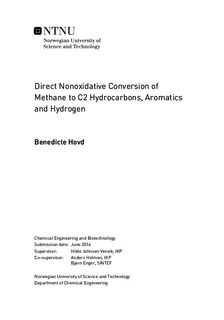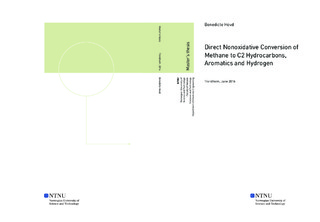| dc.description.abstract | Natural gas contains a large quantity of methane that is valuable as a fuel source. However, it can also be converted to light olefins, but the present synthesis route includes the conversion into synthesis gas. This is an extensive process that could benefit from being replaced by a more efficient direct conversion of methane. Several routes for direct conversion of methane has been developed, but none have proven to show the right degree of reactivity or selectivity that is required.
A new catalyst has been suggested in the article Direct, nonoxidative conversion of methane to C2 hydrocarbons, aromatics and hydrogen . The catalyst, which is claimed to have single iron sites, is reported to activate the C-H bond in methane, while at the same time preventing further dehydrogenation and C-C coupling. The selectivity to desired products was found to be over 99 %, and ethylene, benzene and naphthalene were the only products. Several other catalysts were also prepared, including the Fe/HZSM-5 catalyst. The product distribution obtained with this catalyst was promising, despite the formation of coke. The materials used to produce the Fe@SiO2 catalyst were synthesized fayalite and silica. The fayalite and silica was ball milled, fused together and leached to create the catalyst. The Fe/HZSM-5 (1) catalyst was prepared by zeolite impregnation in an iron(III)nitrate solution, followed by calcination. Another catalyst, Fe/HZSM-5 (2), was prepared with the same materials, but with the more conventional incipient wetness impregnation method.
The activity of the catalysts was measured in a reactor using a total space velocity equal to that of Guo et al., and with nitrogen as an internal standard. The activity was measured at four temperatures, 1223, 1273, 1323 and 1373 K. Both Fe/HZSM-5 catalysts displayed activity at 1223 and 1273 K, obtaining significantly higher conversion than for the blank experiment (15-20 % opposed to 1 %). When the reactor temperature was increased to 1323 K the conversion for all four experiments was around 15 %. At 1373 K the conversion had a significant increase, ranging from 30-45 %. The highest conversion was obtained by a blank experiment. The measurements at 1373 K were, however, unsure due to pressure buildup in the reactor, as a result of coke deposition on the catalysts.
As the reactor temperature increased, the selectivity towards acetylene increased as well. In fact, acetylene was observed for all measurements, which was a clear contradiction to the results from Guo et al. Higher hydrocarbons such as benzene and naphthalene could not be detected, and a more in depth analysis of the product stream should be conducted. The Fe@SiO2 catalyst achieved the most desired product composition at 1323 K, having the highest selectivity towards ethylene and producing the least amount of coke. This proved that further examination of the Fe@SiO2 catalyst should be pursued in order to reveal its true potential for methane conversion. | |

